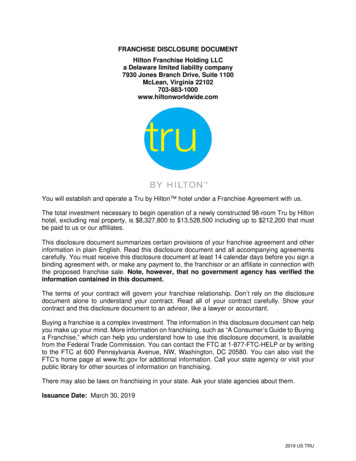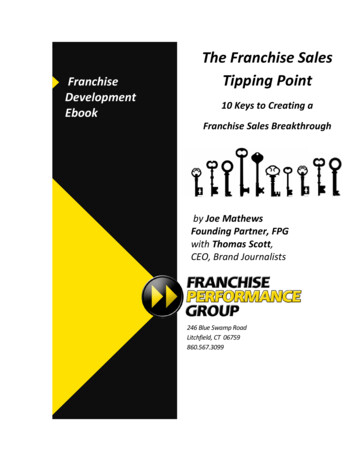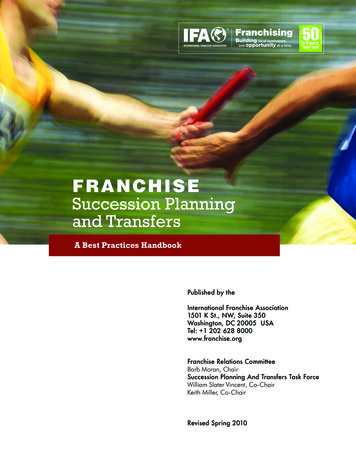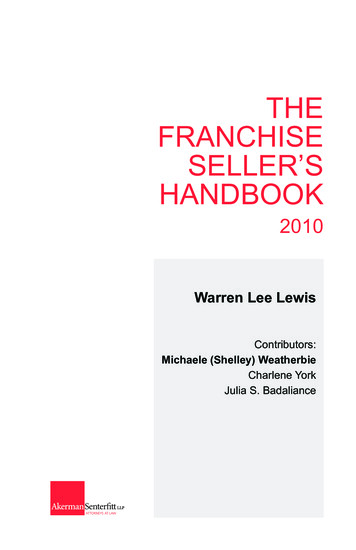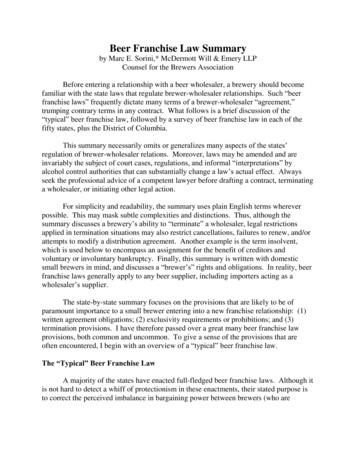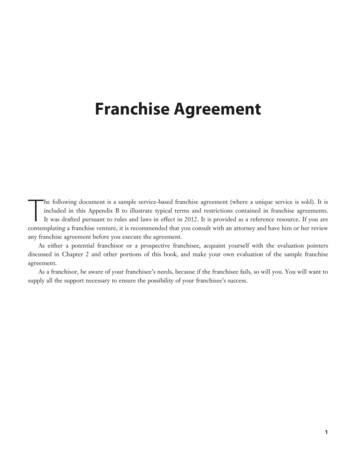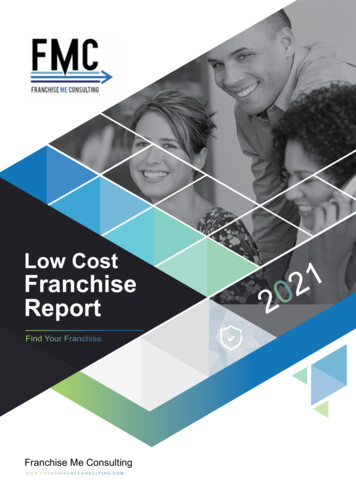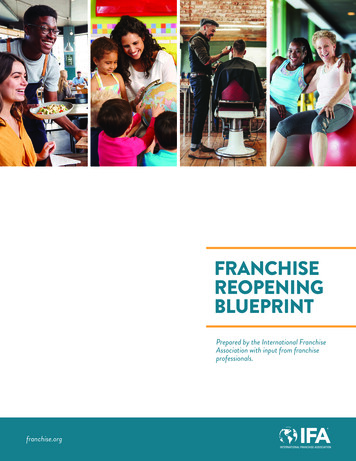
Transcription
FRANCHISEREOPENINGBLUEPRINTPrepared by the International FranchiseAssociation with input from franchiseprofessionals.franchise.org
TABLEOFCONTENTS123Letter from IFAPresident & nBackgroundFRANCHISE SECTOR aning estaurantsSalons/PersonalCare ServicesSenior Care23Additional Resources23Thank You to OurParticipants
Dear IFA member,At the IFA, we live out our mission statement daily: to protect, promote,and enhance franchising. During the COVID-19 pandemic, our mission hasnever been clearer.ROBERT CRESANTI, CFEPresident & CEOInternational Franchise AssociationThe pandemic and ensuing business closures have harmed franchises acrossthe board. In a recent IFA survey, three out of every four franchisebusinesses were fully closed due to either the economic downturn or“stay-at-home” directives. With more than 733,000 franchise businessessupporting nearly 8 million workers prior to COVID-19, it is clear the impactof the pandemic on our sector is and will be tremendous.While franchises have been uniquely harmed, franchises — through afocus on maintaining and executing replicable and scalable operatingsystems, safety standards, and employee training — are also uniquely suitedto help lead the country’s economic revival.We have organized task forces across business lines consisting ofexecutives and franchise owners from the most known and trusted brandsin that industry. Their insights, along with those of government officials andother experts, were crucial in crafting recommendations on how best toreopen businesses while ensuring high standards of safety for employees andcustomers.As per the President’s request to me as a member of his Great AmericanEconomic Revival task force, these considerations and recommendationshave been delivered to the White House, as well as members of Congressand our nation’s governors and mayors. It is IFA’s hope that ourrecommendations can inform reopening guidelines and serve as a baseline forfranchisors and franchisees as they work to reopen their franchise systems.However, our work does not end here. As our country works to safely reopenbusinesses following this crisis, IFA will be here to help your business growand thrive, just as we have for the past 60 years. As seen through theserecommendations, our members working together benefits franchise brandsand local owners of all shapes and sizes alike.I hope that we will soon be safely reopening businesses and returning tonormal. Until that day comes, and from then on, IFA will be there for you.Sincerely,Robert Cresanti, CFEPresident & CEOInternational Franchise Associationfranchise.org1
INTRODUCTIONThese guidelines aim to provide contextualpractices for how franchise businesses canmitigate risk through education and practicesnecessary to protect the health of theiremployees, customers and communities. Toensure we have the most relevant informationto offer, IFA has conducted interviews acrossour Automotive, Commercial Services,Education, Fitness, Hotel, ResidentialServices, Restaurant, Salon/Personal CareServices and Senior Care Services sectorswith franchisors, franchisees and professionaladvisors most knowledgeable in their fields.The IFA membership operates in over 3002IFA FRANCHISE REOPENING BLUEPRINTseparate industries and we can provide a uniquecross-section view of business, the Americanconsumer and how we believe the U.S. consumereconomy can recover quickly. This report setsout our best recommendations for opening andmaintaining businesses after COVID-19.These are our early recommendations thatdraw from the White House guidelines and thediffering rules in the state houses. It is our goal toprovide regulatory bodies with practical guidancewhen making the critical determinations aboutwhich businesses remain open, how best torestore those that will reopen, and the practicesthey should follow to protect their customers.Our work in this area is to support the effortsto instill confidence in businesses and rapidlyrestore our nation’s economy.
FranchisingSnapshot(Prior to RANCHISEEMPLOYEES75%OF FRANCHISE OWNERSHAVE FEWER THAN 20EMPLOYEES30%OF FRANCHISES AREMINORITY-OWNEDBACKGROUNDFounded in 1960, the International Franchise Association(IFA) is the world’s oldest and largest organizationdedicated to promoting, protecting, and enhancing thefranchise business model. IFA advocates for America’s733,000 franchise businesses across 300 business lineswho together employ 7.6 million American workers.Franchising is an arrangement where a name brandcompany grants a local entrepreneur the right to use itsbusiness name, trademarks, and processes to produce andmarket a good or service. The business owner usually pays aone-time fee and a percentage of sales revenue as royalty.Typically, the brand provides national advertising andsupport, while the independent owner is responsible forday-to-day operations of the business, including hiring andscheduling employees.It’s no exaggeration to say that American franchises arethe backbone of the small business entrepreneur in ourcountry. In past recessions, the business model has provento be resilient and a leading expansion method comingout of economic downturns that should be encouraged.Prior to COVID-19, America had 733,000 franchiseestablishments that employed more than 7.6 millionAmericans. The vast majority of these franchise owners aresmall business owners in every sense.According to industry research firm FRANdata, 75%of all franchise owners have fewer than 20 employees.Franchising is also more diverse than non-franchisebusinesses: according to U.S. Census data, nearly 30% offranchises are minority-owned, compared to 18% of nonfranchised businesses.Franchises are found in nearly every sector of theeconomy. In fact, less than half of all franchises are in thefood and beverage industry. Other major sectors includeautomotive, commercial services, education, gyms, hotels,residential services, restaurants, salons, senior healthservices, etc. According to an IFA survey, 74% of franchisebusinesses in the country are closed due to COVID-19.franchise.org3
CROSS-INDUSTRYCONSIDERATIONSThese considerations shall be read in conformitywith federal, state, and local laws as well as anyapplicable federal, state, and local reopeningguidelines.Franchising’s Work ForceThe work force in franchising includes essentialand non-essential workers and for both groups,all franchisees and franchisors have focusedoverwhelmingly on planning for how to best protectthem. Franchisors have been routinely distributingto their franchisees, at-cost, Personal ProtectiveEquipment (PPE) that their staff will require.Franchisors, in conjunction with the IFA has alsobeen researching and creating safe environmentsfor our staff and customers.Recommendations for Returning toWorkIn the home: In addition to sending reminders toreinforce Centers for Disease Control & Prevention(CDC) guidelines we recommend employeesmonitor their health and report symptoms to theiremployers, and anyone that may be sick at home. Inthe absence of wide-spread testing, self-reportingof the employees and family’s health is a way tohelp reduce symptomatic and non-symptomatic(employee feels fine, however has sick familymember) people in public and commercial spaces.Arriving to Work/Job Sites – SafeRoutinesEmployers should disseminate through theircommunication channels CDC guidelines foremployees to familiarize themselves on what to do ifyou or someone in your household becomes ill. Recommendations for Getting to WorkTransportation plans: It is common for co-workersto share a ride to work. It is our recommendationgoing forward that when possible workers use their4own vehicle. Where public transportation is used,the CDC’s guidance on face masks and socialdistances should be emphasized. There should bestrict adherence to social distancing, use of facemasks, and hand washing upon entering a jobsite. For some of our companies, including thosein residential services, many are recommendingthe installation of hand washing into their servicevehicles and requiring hand sanitizing and otherprotective gear when that is not possible.IFA FRANCHISE REOPENING BLUEPRINTIFA members work sites by the nature ofour businesses are varied. We have thereforemade recommendations that franchisors andfranchisees will need to modify in the context oftheir unique businesses. Each of the individualvertical recommendations will be found in thecorresponding section below and will include: Personal Protective EquipmentCOVID-19 screeningPotential changes to work and consumer spacesRecommendations where queues occurContactless payment should be an acceptedform of paymentMobile ordering and drop-off/pick-up relocatedto front of store (where feasible)SafetyCustomer and staff communication
Recommendations for the protection of workersinclude: Staggered worker arrival for meetings,training or to receive their work/job schedulesIf in-person employee meetings are needed,it should be structured to allow employees toattend in a manner that permits appropriatesocial distancingTelework and video training, where feasibleand applicableSocial distancing in breakrooms and internaleating areas should be limited. If socialdistancing is not feasible, break rooms shouldbe closed.Workspaces should meet socially distancingguidelines and where not feasible, plexiglass orother barriersStaggered shifts to isolate critical staff toensure business continuityIn office locations, well-marked one-waypaths between offices and other spacesTouchless entry and elevators and where thatis not feasible, hand sanitizers made readilyavailableFloor graphics and signage to highlightsocially distanced spacesSneeze guards and plexiglass barriers tomitigate COVID-19 spreadDisinfection of all tools and other materialsthat come into contact with workers orconsumersCommunication to all staff on mitigationrules and education on why policies have beeninstituted.franchise.org5
CONSUMER-FACINGRECOMMENDATIONSBusiness CommunicationFranchise systems recognize that consumers willhave understandable concern as the economybegins to be opened. Thanking consumers fortrusting in our efforts to keep them safe should becontinually communicated and highlighting thatthe brand and franchisee have taken every effortto mitigate risk and create a safe environment forthem to enter. Communications should be sent tocustomers about what to expect upon coming backto their place of business.Upon approaching a place of business there shouldbe clear visual communication of new socialdistancing expected of consumers. This can includebut not be limited to floor and window decalscommunicating in-store requirements, trafficpatterns and protective barriers. If a location is usinga sanitary service, it would be appropriate for a decalcertifying the daily treatment in a visible location.OccupancyTo satisfy CDC’s social distancingrecommendations, states have adopted approachesfor their markets, some of which have createda patchwork approach in defining the numberof people allowed in any location. Many stategovernors are adopting a recommendation for anoccupancy rate of 25% which creates a range ofbetween 5 to 20 people per 1,000 square feet onaverage. While we see the benefit of localization, webelieve this will create confusion for both businessesand consumers.The IFA is recommending there be morestandardization based on a percentage of localfire marshal occupancy levels in non-hotelestablishments.Location layouts, ingress and egress, internalstructures and availability of outside spaces should6IFA FRANCHISE REOPENING BLUEPRINTbe created to minimize physical and particlecontact. Compliance technologies, monitoringoccupancy, cleaning and sanitation requirementsthat are Personally Identifiable Information (PII)compliant (i.e. LIDAR) should also be considered.Where business owners feel appropriate, staff canbe assigned to limit access by customers to thebusiness establishment. It is also expected thatbusiness owners will educate their consumers onhow they should conduct their activities fromentering and exiting the location, queuing, ordering,seating, pickup, delivery, wearing face masks andpayment.Employers should focus on communications,signage, and advance communication to consumersto help educate them on any occupancy changes.
LEGISLATIVERECOMMENDATIONSPrior to the impact of COVID-19, the franchiseeconomy experienced nine consecutive years ofgrowth, with a significant increase in the last severalyears across all sectors. Now, as the economybegins to reopen across America following thegreatest economic downturn in a generation in justtwo months, IFA is proposing a series of pro-growthpolicies aimed at ensuring America’s franchisebusinesses can return to their pre-pandemic levelsas quickly as possible, and as many jobs as possiblecan be saved.The steps the administration and Congress havetaken as part of the CARES Act, specificallythe Paycheck Protection Program (PPP), havebeen a successful first step to provide short-termfinancial assistance to keep employees connectedto employers and provide support for other debtobligations our members are facing.Nevertheless, it is clear that additional supportand assistance from the federal government willbe necessary as the economy begins to reopenand both essential and non-essential businessesmake plans to open. We propose a multi-prongedapproach to ensure business continuity, consumerand employee safety, employee retention andliability protections that will help franchisebusinesses get to the other side of the pandemicwith the least amount of harm possible.Develop an American Recovery FundCurrent steps that have been taken by Congress todate are not enough to help businesses recover. Theprograms enacted thus far provided much-neededhelp in the short term, and we need to build uponthe current options to address the overwhelmingneed for additional capital support to businesses. Abroad-based, efficient recovery fund that does notpick winners and losers is the best path forward.The fund will be a grant-based federal assistanceprogram to power the resilience of Americanenterprise. It creates liquidity that workplaces canaccess, through a simple application, to retain andrehire staff, pay rent, meet certain debt obligations,and pay state and local taxes.Extend, Expand and Improve thePaycheck Protection ProgramMaximize eligibility and create more flexibility forbusinesses to support their employees and keeptheir businesses afloat.Maximize Franchise Eligibility in the PaycheckProtection Program – Congress intendedto maximize franchise eligibility in the PPPby providing a waiver of the SBA affiliationrules. However, SBA guidance issued on April13, 2020, led to numerous denials of eligibilityto nearly 100 franchise brands, comprising35,500 franchised small businesses and 160,000employees who are not on the SBA FranchiseDirectory. Maximizing eligibility will ensure theworkforce can stay connected to their employers.Franchisors with corporate locations or franchiseesfranchise.org7
that meet the definition of a business formatfranchise under part 436 of title 16, Code ofFederal Regulations should be eligible for a PPPloan, so long as any single location has less than500 employees per location.Alter the 75/25 PPP ratio that limits non-payrollcosts to 25% of the loan –A 50/50 ratio toaccount for debt service, such as utilities and rent,would provide greater relief during the pandemicand better protect small businesses from failure.Many of these small businesses – gyms, daycarecenters, salons, and the like – are fully closed and indesperate need of maximum relief to cover payrolland non-payroll expenses. Because of the agencies’decision to adopt a 25% non-payroll restriction,the businesses which have been hit the hardest willreceive less aid.Amend the requirement that PPP payroll proceedsbe used in the immediate eight consecutive weeksfrom loan origination – This will provide fully closedsmall businesses the flexibility to rehire workersonce the stay-at-home orders are lifted and nonessential businesses are allowed to reopen.8IFA FRANCHISE REOPENING BLUEPRINTAmend the PPP loan term from 2 to 10 years, asoriginally intended by the CARES Act.Increase the maximum PPP loan to 8 months ofcovered costs – PPP loans should cover both payrolland operational expenses to ensure employees havea business to return to post health crisis.Extend the covered period for loan forgivenessunder PPP to December 31, 2020 and considerautomatic refunding triggers based on economicindicators – The current date of June 30 is notrealistic based on shelter in place orders anticipatedreturn of demand and business operations.Separate PPP from 7(a) loan program – The PPPhas been overwhelmingly popular and necessaryin recent weeks and needs to be prioritized andoperate independently from the traditional 7(a) loanprogram.
Liability ProtectionFranchise businesses are currently preparingtheir employees, management teams, facilities,equipment, products, and services as the nation’seconomy gets set to reopen and this has beena momentous task considering the rules andrequirements related to COVID-19 are changingfrequently. Business owners are doing their bestto follow the federal and state guidelines, whichsometimes change every week, if not everyday. Due to this uncertainty, we are becomingincreasingly concerned about efforts by theplaintiff’s bar to take advantage of small businessowners who are trying to follow the law andapplicable state and federal guidelines related to thevirus. Uncertainty in the law creates an opportunityfor some to take advantage of our nation’s legalsystem and rules, which has a disproportionateeffect on small businesses, who generally lackinternal counsel and human resources staff. Forthis reason, we strongly believe Congress and theAdministration should provide Good Samaritanprotection to business owners who follow theprotocols from frivolous lawsuits pertainingspecifically to COVID-19 claims arising from bothemployees and customers.Joint employer liability protection – Franchisorsand franchisees will be working to implementnew policies and procedures to protect workersand employees from COVID-19. The creationand implementation of brand standards ensuringconsumer safety is a hallmark of the franchisemodel. Congress should make clear that franchisorsand franchisees are not jointly responsible for theterms and conditions of employment over the samegroup of employees.Unemployment insurance (UI) benefits — IFAsupports providing furloughed or unemployedworkers with additional unemployment insurancebenefits during the pandemic. However, we urgeCongress, the administration and state policymakersto ensure UI enhancements are capped at levelscommensurate with employees wage rates beforethe pandemic. Doing so will ensure demand existsfor jobs to return to when offered by employersafter stay-at-home orders are lifted and a businesscan reopen. Furthermore, enhanced UI benefitsthat exceed an employees’ previous pay rate createperverse incentives for employers seeking to bringemployees back and receive loan forgiveness as partof the PPP.Franchise fairness – Congress and state policymakers must recognize small business franchiseowners as being similarly situated to non-franchisesmall business owners. Labor policies, access toloans/grants and all other legislative and regulatoryefforts should ensure equal treatment of franchiseesas non-franchise businesses.Business interruption insurance – Congress shouldensure existing business interruption coveragecovers losses related to COVID-19. Requiringcoverage will provide comprehensive relief andassistance to residents and local business ownersbeing denied coverage.franchise.org9
FRANCHISESECTORSUMMARIESAUTOMOTIVEBACKGROUNDMany automotive service outlets have remained open,having been deemed as essential businesses. Manybest practice standards have been in place and arebeing refined for a full return to commerce.General Recommended Guidelines 10IFA FRANCHISE REOPENING BLUEPRINTEncourage services by appointment where feasible.Limit the number of walk-in customers permitted in thefacility based on size and/or local regulations.All customers and employees should wear a facemask.Post signage at the door stating that any customer whohas experienced COVID-19 symptoms should alert therepair shop so that employees are aware.All cars should be disinfected inside and out both beforethe service begins and after the work is completed.Offer contactless drop-off and pick up for service.Offer contactless service recommendation review as wellas payment.
FRANCHISESECTORSUMMARIESCOMMERCIAL CLEANING SERVICES BACKGROUNDCommercial services franchise leaders will be workingtoward enhancing current best practice standards fortheir businesses and franchisees based on updates setforth by the CDC related to COVID-19.General Recommended Guidelines Consider daily temperature checks prior to startingworkday. CDC guidance states the minimum temperaturethat indicates a fever is 100.4 F.Practice social distancing.PPE should be worn at all times.Communication should be provided to customers as towhat measures are being taken to keep everyone safeduring service.Employees should be encouraged not to carpool to servicelocations when feasible.Ask customers to wear PPE. Provide additional training and certifications wherepossible.Providing a safe in-office working environment:» Employees should wear PPE.» Practice social distancing.» Consider rearrangement or removal of breakroomand common areas where congregation of employeescould occur.» Continue allowing and encourage workingremotely. Increase technology offerings to help makethis easier for all staff.» Consider staggering workforce so buildings have40% or less employees at one time.» Continue and increase cleaning and sanitizing ofoffice buildings.franchise.org11
FRANCHISESECTORSUMMARIESEDUCATION BACKGROUNDMany educational and childcare institutions haveremained at least partially open during the pandemic,the majority of them, in order to service childcareneeds for essential workers only. These locations havetaken strong and proactive measures to keep thoseremaining employees and families safe and learnedvaluable safety lessons which will be applicable goingforward. These efforts will be amplified as theyprepare to bring back staff and allow all families toreturn to the schools.General Recommended Guidelines 12All employees and children should be visually examinedfor symptoms have temperatures taken daily beforebeing admitted to work or attend school. CDC guidancestates the minimum temperature that indicates a fever is100.4 F.Only children and staff should be permitted in thefacility.IFA FRANCHISE REOPENING BLUEPRINT Parents should drop children off in front of the schoolwhere they are escorted inside by an employee.Occupancy levels should be addressed (Max numberof students per facility vs. number of people per squarefoot). This should be done in conjunction with any stateor local mandates.Meet requirements for sanitizing all toys and equipmentin facilities.Contactless payments should be offered.Family groups should be kept together in classrooms.Encourage attendance initiatives such as staggering classdays or A/B Team scheduling.Offer education at home programs where possible.Consider tuition relief/credits for essential workers.Only one teacher per classroom where feasible.» No ancillary staff or assistant teachers should beallowed in classes.Practice social distancing.Practice student social distancing when possible, e.g.circle and mat times.Students should be kept home if they are sick or showingsigns of illness.Parents should be directed to wear PPE if there is anyinteraction required with staff outside school at drop offor pickup.
FRANCHISESECTORSUMMARIESFITNESS BACKGROUNDGyms and fitness franchises across the country have beenforced to close during the pandemic. With appropriatemeasures taken to ensure employee and consumer safety,these businesses can reopen and provide much neededhealth and well-being outlets for consumers. General Recommended Guidelines Practice social distancing throughout the facility.Where practical, equipment should be spaced 6 feet apartor every other piece of equipment to be used, allowing forphysical separation. The non-used equipment should bepowered down, roped off and signage placed on it.All employees should wear a facemask.Post signage at the door stating that any customer whois currently experiencing COVID-19 symptoms is notpermitted to enter.Hand sanitizer should be prominently available throughoutthe facility.All equipment should be cleaned frequently and/or inbetween each guest/user. Customers should be directed to wait in their car or outsideuntil space is available based on occupancy limits.Ask customers to use app-based technology to scheduleappointments, handle payment transactions, and keep upwith all communications.Consider reducing the size of classes or eliminating inperson training.All customers should be directed to wash hands uponentering the facility.If customers are waiting for their appointment outside, visualcues should be used to designate safe social distancing.» There should only be enough equipment in thefacility to accommodate the number of guests, plus floorspace for guests to do exercising while maintaining socialdistancing protocols.One-way direction set up, no customer passing each otheror looping back to a piece of equipment. Signage on thefloor, walls and self-standing to be added to aid in newlayout.Customer should be directed to provide his/her ownhydration/water bottles. No re-filling stations should beavailable. Sealed, single use items may be provided.Bathrooms should be routinely cleaned using CDCapproved cleaning products.Consider elimination or closure of non-bathroom facilities inlocker room areas such as saunas, tanning facilities, etc.franchise.org13
FRANCHISESECTORSUMMARIESHOTELSBACKGROUNDAs a backbone of Americans’ ability to travel for work andpleasure, hotels are a vital part of the economy. Supportingthousand of direct jobs and thousands more indirectly, itis important to develop safe and effective ways for theseestablishments to begin welcoming guests back. General Recommended Guidelines 14Practice social distancing throughout facilities, especially incommon space, lobbies, etc.All employees should wear a facemask.Consider signage discouraging entrance to anyoneexperiencing COVID-19 symptoms.Hand sanitizer should be prominently provided in commonspace, lobbies, at elevator and escalator banks.Follow all cleaning guidelines put forth from the CDC.Ask guests to download and use the brand app prior to arrivalfor check-in/check-out, hotel communications, services,maps, etc.Entering:» When feasible, only guests with reservations shouldenter the property.IFA FRANCHISE REOPENING BLUEPRINT » Guests should be directed to follow social distancingguidelines, aided by signage placed on stands, doors, and floors.» All guests should be directed to use hand sanitizer that isreadily available in common spaces.Queuing:» If guests are waiting, visual cues should be used todesignate safe social distancing.» Consider removing excess furniture from the lobby andcommon space areas to encourage social distancing.» Directional signage and floor stickers should be used in allhigh traffic locations, including lobby spaces, common areas,elevator and escalator banks.Rooms:» Hotel rooms should be cleaned upon check-out and notdaily or in accordance with brand standards.» All coffee pots, in-room food service items, paperamenities and toiletries should be removed.» Hand sanitizer and cleaning wipes should be madeavailable for purchase or gratis in-room or onsite.» Single serving, prewrapped food or beverage items shouldavailable.Bathrooms:» Public restrooms are cleaned throughout the day. Guestbathrooms cleaned upon checkout.» Signage to include recommended hand washingprocedures and overall bathroom cleaning procedures shouldbe placed prominently.
HOTEL RECOMMENDATIONSfranchise.org15
FRANCHISESECTORSUMMARIESRESIDENTIAL SERVICES BACKGROUNDProviding quality services inside and outside consumers’homes and covering a wide variety of services, thereare broad recommendations that will be helpful to thereopening or continued safe operation of residentialservice brands. General Recommended Guidelines 16Services should be by appointment only.» All appointments should be confirmed with a prescreening call. Screeners should ask about the health ofthe home/site, anyone showing signs of COVID-19, theuse of facemasks for anyone who will be at the home/site.» Communications should be sent prior to theappointment outlining safety protocols.Practice social distancing.PPE should be worn by employees and customers.Hand sanitizer should be provided for all employees to taketo job sites.Ask customers to limit their contact with employees whilework is being completed.IFA FRANCHISE REOPENING BLUEPRINT Ahead of a visit, customer should be contacted todiscuss any new procedure(s), additional precautions andencourage the use of PPE by the customers.Employee should discuss all extended safety and cleaningmeasures with the customer prior to starting any work toensure a safe environment.Employees should clean the work area entirely prior toleaving the site, following cleaning procedures outlined incommunications to the customer.Where possible, install hand washing/sanitizing stations onemployee vehicles.Payments should be processed via touchless systems oronline.
FRANCHISESECTORSUMMARIESRESTAURANTSBACKGROUNDAs one of larges
Prior to COVID-19, America had 733,000 franchise establishments that employed more than 7.6 million Americans. The vast majority of these franchise owners are small business owners in every sense. According to industry research firm FRANdata, 75% of all franchise owners have fewer than 20 employees. Franchising is also more diverse than non .

